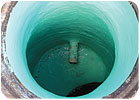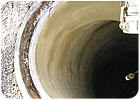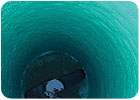FIELD-APPLIED COATINGS: Solving a Stinky Situation
All across the U.S., manholes are under attack. The enemy? Corrosion - a result of increasingly corrosive sewage in aging sewer systems that are further weakened by extended hold and travel times, as well as increased capacity demands. Fortunately, epoxy coatings designed to meet the immersion service needs of the wastewater industry can extend the life of manholes by 50 years or more while providing significant savings in downtime, labor and installation costs.

All across the U.S., manholes are under attack. The enemy? Corrosion - a result of increasingly corrosive sewage in aging sewer systems that are further weakened by extended hold and travel times, as well as increased capacity demands. Together, these factors are the basis for the nation’s crumbling wastewater infrastructure, a critical issue for the U.S. Environmental Protection Agency (EPA), as well as states and municipalities throughout the nation.
Many of the country’s 16,000 sewage pipes are 50 or even 100 years old and are feared to be leaking sewage into the environment. Unprotected brick and concrete cannot stand up to the increased aggressive composition of the waste stream, including corrosive chemicals and constant abrasion from media in the sewage, as well as the generation of increased amounts of hydrogen sulfide and sulfuric acid. The EPA estimates that it will cost $390 billion over the next 20 years to repair or replace the 16,000 existing wastewater treatment systems and build new ones to accommodate increasing demand. The responsibility to pay for these upgrades rests mostly with local authorities.
Historically, repair options have included using epoxy coatings, plastic sleeves and cement to rebuild the substrate. However, today’s utility directors are looking for long-term and cost-effective solutions to upgrade their sewer systems. A system that lasts 50 years is significantly less costly and more environmentally conscious than a band-aid fix lasting five or 10 years. A longer-lasting system begins with cleaning and restoring the substrate, followed by the proper installation of a chemical- and abrasion-resistant barrier that adheres to the concrete and can withstand today’s more aggressive environments, including sulfuric acid and hydrogen sulfide gas, for maximum protection and durability.
The cost of the barrier material alone is no longer the primary concern. Rather, utility directors are also looking at the total cost to install the system from start to finish, as well as the “downtime costs” of having a sewage pipe and manhole out of service, necessitating temporary rerouting of traffic and sewage streams. Public opinion is also important as taxpayers are inconvenienced by road closures and increasing utility rates.
For more information about epoxy coatings, visit www.envirolinegroup.com.

The city of Coconut Creek, just west of Ft. Lauderdale, is one such city in need of repair. The city’s collection system consists of 147.2 miles of concrete gravity sewer, 94 lift stations, and 33.30 miles of force mains. After analyzing the infrastructure, the city chose the six manholes that had suffered the most from the effects of sulfuric acid to upgrade first. After analyzing all the costs, the city calculated it would need to spend $4,000 a day just to take a manhole or lift station out of service to repair it, plus the cost of the repair. Subsequently, the city was determined to find a solution that could provide a quick turnaround and protect the manholes from further corrosion for many years to come.
After considering various epoxy and cementitious materials, Coconut Creek chose Enviroline 222 epoxy to restore its manholes due to its single-coat, fast-cure application that would get the manholes back into service quickly. The city also appreciated the coating’s high resistance to sulfuric acid and its slick surface that is easier to clean and inspect.
The contractor for the job, Environmental Coating Services, LLC, LaPlace, LA, first pressure cleaned the surface twice at 3500 psi using a soapy bleach and 180°F (82°C) water, followed by sandblasting the surface. Next, cracks were repaired with a cementitious material. After grouting was completed, the manholes were quickly brush-blasted and followed with a light spray-applied coat of Enviroline 57X epoxy sealer. The Enviroline 222 lining was then roller applied at about 30 to 40 mils and allowed to cure at ambient temperatures.
The city saved one extra day of downtime for every manhole repaired by using a single-coat lining instead of a multicoat system, which ultimately provided a minimum of $24,000 cost savings. The city of Coconut Creek cost-effectively won the war against sulfuric acid corroding its manholes and has since repaired several more manholes and lift stations using the epoxy coating.

One such city, Denham Springs, LA, needed to rehabilitate two lift stations and two brick manholes. The manholes were built in the 1950s and suffered from decay. The city originally thought it needed to dig up and replace the manholes, a job that would be costly for the city and a headache for city travelers. Enviroline explained to city officials that they did not need to replace the manholes, recommending instead that they use the Enviroline 222 moisture-tolerant lining to rehabilitate their system. Repairing the manholes would cost the city less than half of what it would pay to replace the manholes.
The city hired Environmental Coating Services to do the job. The project began with pressure cleaning the surface twice at 3500 psi using a soapy bleach and 180°F water, followed by sandblasting the surface. Next, the joints of the brick surface were regrouted with a cementitious material, and the entire brick surface covered over with a cementitious surface for added strength. After cementing was completed, the manhole was sandblasted again and followed with a light spray-applied coat of Enviroline 57X epoxy sealer. Enviroline 222 lining was then spray applied at about 30 to 40 mils. As this job was occurring in cooler months, a 10 k heater was used to speed the cure of the product. (A low-temperature cure version of the epoxy has since been developed).
The entire job, from surface preparation to coating cure for the two lift stations and two manholes, took only two weeks to complete and saved the city tens of thousands of dollars. The city was pleased with the outcome and has since used the moisture-tolerant lining for several more manholes and lift stations.

A single-coat, fast-cure epoxy coating will protect this manhole from corrosion for many years to come.
All across the U.S., manholes are under attack. The enemy? Corrosion - a result of increasingly corrosive sewage in aging sewer systems that are further weakened by extended hold and travel times, as well as increased capacity demands. Together, these factors are the basis for the nation’s crumbling wastewater infrastructure, a critical issue for the U.S. Environmental Protection Agency (EPA), as well as states and municipalities throughout the nation.
Many of the country’s 16,000 sewage pipes are 50 or even 100 years old and are feared to be leaking sewage into the environment. Unprotected brick and concrete cannot stand up to the increased aggressive composition of the waste stream, including corrosive chemicals and constant abrasion from media in the sewage, as well as the generation of increased amounts of hydrogen sulfide and sulfuric acid. The EPA estimates that it will cost $390 billion over the next 20 years to repair or replace the 16,000 existing wastewater treatment systems and build new ones to accommodate increasing demand. The responsibility to pay for these upgrades rests mostly with local authorities.
Options for Upgrades
Replacing a sewage pipe and manhole is extremely costly, with some estimates as high as $25,000 per manhole, depending on the project size and specifics. Older structures made of brick can be significantly more costly and complex to replace than newer structures made of concrete. However, even concrete sewage pipes and manholes face potential problems that can occur from digging up a sewer pipe, leading to increased costs and liability, such as collapsing nearby laterals. With hundreds of manholes in a single city, most municipalities can only afford to replace the most severely corroded and deteriorating sites.Historically, repair options have included using epoxy coatings, plastic sleeves and cement to rebuild the substrate. However, today’s utility directors are looking for long-term and cost-effective solutions to upgrade their sewer systems. A system that lasts 50 years is significantly less costly and more environmentally conscious than a band-aid fix lasting five or 10 years. A longer-lasting system begins with cleaning and restoring the substrate, followed by the proper installation of a chemical- and abrasion-resistant barrier that adheres to the concrete and can withstand today’s more aggressive environments, including sulfuric acid and hydrogen sulfide gas, for maximum protection and durability.
The cost of the barrier material alone is no longer the primary concern. Rather, utility directors are also looking at the total cost to install the system from start to finish, as well as the “downtime costs” of having a sewage pipe and manhole out of service, necessitating temporary rerouting of traffic and sewage streams. Public opinion is also important as taxpayers are inconvenienced by road closures and increasing utility rates.
Epoxy Coatings
Epoxy coatings have been used successfully for decades in numerous industries with highly corrosive environments, including oil and gas, petrochemical, chemical processing, transportation, and pulp and paper industries. However, not all epoxies are the same, as adhesion, chemical resistance, abrasion resistance and ease of application differ between epoxies and manufacturers. Some of the most advanced coatings designed to meet the specific immersion service needs of the wastewater industry provide:- Superior chemical resistance, including resistance to hydrogen sulfide (H2S), H2S gas and sulfuric acid
- Impact and abrasion resistance
- Excellent adhesion to concrete
- The ability to be applied to damp surfaces
- A 100% solids formulation for minimum shrinkage during cure
- No volatile organic compounds (VOCs), which makes them safer for the environment and for workers to apply
- The ability to be applied in a single thick-film coat (20+ mils) to avoid intercoat adhesion problems and to speed application
- A fast cure rate, with some systems curing in only eight hours at 77°F (25°C)
- A monolithic, ceramic-like finish that can reduce maintenance costs by 20 to 30%
For more information about epoxy coatings, visit www.envirolinegroup.com.

Coconut Creek chose Enviroline 222 epoxy to restore its manholes due to its single-coat, fast-cure application that would get the manholes back into service quickly.
SIDEBAR: Case Study: Concrete Manholes in Coconut Creek, FL
As one of the nation’s fastest-growing states, adding roughly 800,000 new residents each day, Florida is particularly challenged when it comes to funding the expansion of its wastewater systems to accommodate this growth while simultaneously upgrading its existing system. The American Society of Civil Engineers estimates that Florida has $9.6 billion in wastewater infrastructure needs.The city of Coconut Creek, just west of Ft. Lauderdale, is one such city in need of repair. The city’s collection system consists of 147.2 miles of concrete gravity sewer, 94 lift stations, and 33.30 miles of force mains. After analyzing the infrastructure, the city chose the six manholes that had suffered the most from the effects of sulfuric acid to upgrade first. After analyzing all the costs, the city calculated it would need to spend $4,000 a day just to take a manhole or lift station out of service to repair it, plus the cost of the repair. Subsequently, the city was determined to find a solution that could provide a quick turnaround and protect the manholes from further corrosion for many years to come.
After considering various epoxy and cementitious materials, Coconut Creek chose Enviroline 222 epoxy to restore its manholes due to its single-coat, fast-cure application that would get the manholes back into service quickly. The city also appreciated the coating’s high resistance to sulfuric acid and its slick surface that is easier to clean and inspect.
The contractor for the job, Environmental Coating Services, LLC, LaPlace, LA, first pressure cleaned the surface twice at 3500 psi using a soapy bleach and 180°F (82°C) water, followed by sandblasting the surface. Next, cracks were repaired with a cementitious material. After grouting was completed, the manholes were quickly brush-blasted and followed with a light spray-applied coat of Enviroline 57X epoxy sealer. The Enviroline 222 lining was then roller applied at about 30 to 40 mils and allowed to cure at ambient temperatures.
The city saved one extra day of downtime for every manhole repaired by using a single-coat lining instead of a multicoat system, which ultimately provided a minimum of $24,000 cost savings. The city of Coconut Creek cost-effectively won the war against sulfuric acid corroding its manholes and has since repaired several more manholes and lift stations using the epoxy coating.

The entire job in Denham Springs, from surface preparation to coating cure for the two lift stations and two manholes, took only two weeks to complete and saved the city tens of thousands of dollars.
SIDEBAR: Case Study: Brick Manholes in Denham Springs, LA
Like Florida, Louisiana is also feeling the squeeze on budgets from an aging infrastructure. Though not experiencing the same surge in new residents as in Florida, damage to wastewater utilities from Hurricane Katrina has brought unique challenges to city officials. In 2005, the American Society of Civil Engineers estimated that Louisiana had $2.37 billion in wastewater infrastructure needs. A 2006 report prepared for the Water Environment Federation by Black & Veatch Corp. estimated that the total effect of Hurricane Katrina on wastewater utilities approached $1.4 billion. Those municipalities not affected by Hurricane Katrina are more challenged than ever to obtain federal and state funding for their basic infrastructure repairs, thereby placing as much importance on the overall cost as on the longevity of the upgrades.One such city, Denham Springs, LA, needed to rehabilitate two lift stations and two brick manholes. The manholes were built in the 1950s and suffered from decay. The city originally thought it needed to dig up and replace the manholes, a job that would be costly for the city and a headache for city travelers. Enviroline explained to city officials that they did not need to replace the manholes, recommending instead that they use the Enviroline 222 moisture-tolerant lining to rehabilitate their system. Repairing the manholes would cost the city less than half of what it would pay to replace the manholes.
The city hired Environmental Coating Services to do the job. The project began with pressure cleaning the surface twice at 3500 psi using a soapy bleach and 180°F water, followed by sandblasting the surface. Next, the joints of the brick surface were regrouted with a cementitious material, and the entire brick surface covered over with a cementitious surface for added strength. After cementing was completed, the manhole was sandblasted again and followed with a light spray-applied coat of Enviroline 57X epoxy sealer. Enviroline 222 lining was then spray applied at about 30 to 40 mils. As this job was occurring in cooler months, a 10 k heater was used to speed the cure of the product. (A low-temperature cure version of the epoxy has since been developed).
The entire job, from surface preparation to coating cure for the two lift stations and two manholes, took only two weeks to complete and saved the city tens of thousands of dollars. The city was pleased with the outcome and has since used the moisture-tolerant lining for several more manholes and lift stations.
Looking for a reprint of this article?
From high-res PDFs to custom plaques, order your copy today!





